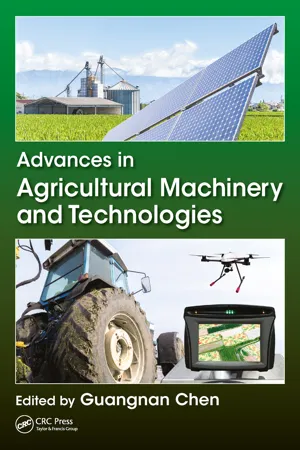1.1Introduction
1.2Agricultural Mechanization
1.2.1Levels of Agricultural Mechanization Technology
1.2.2Large-Scale Agricultural Fields
1.2.3Small-Scale Agricultural Fields
1.2.3.1Mechanization in Small-Scale Agricultural Fields
1.2.3.2Development and Applications of Two-Wheel Tractors
1.3Present-Day Technology
1.4Case Studies
1.4.1Rice Production in the Philippines
1.4.2Palm Oil Production in Malaysia
1.4.3China’s Agricultural Mechanization Development Program
1.5Challenges of Mechanization
1.5.1Technical Challenges
1.5.2Requirements of Energy and Fuels for Machinery Operations
1.5.3Impact of Government Policies
1.5.4Technology Transfer Mechanisms
1.6Future Outlook
1.7Conclusion
Acknowledgments
References
1.1Introduction
Agricultural production involves almost all aspects of cultivation, harvesting, processing, storage, and transportation of crops, animals, food, and fiber. Agricultural production depends heavily on the availability of agricultural inputs such as labor, water, arable land, and other resources (energy, fertilizer, etc.), which are significantly affected by the type and scale of farm practices.
In many developing countries, agricultural production offers significant employment opportunities, food security, and economic development to local people. However, for sustainable agricultural production, efforts must be made to introduce changes in order to increase crop yields, efficiency, and sustainability. According to Akinyemi (2007), this can only be effectively achieved by the application of adequate, mechanized agricultural practices.
The advancement in the mechanization of agricultural production in developing countries in Asia, Africa, and Latin America has been discussed and reported in the past few years (Diao et al., 2014; Deininger and Byerless, 2012). Sims, Helmi, and Keinzle (2016) also gave an excellent summary of the context of agricultural mechanization in sub-Saharan Africa. They analyzed the current challenges being faced, including affordability, availability, lack of farmer skills, constraints within the private sector, and gender issues. Opportunities for improvement by sustainable crop production systems, agricultural mechanization development, and further investment were studied. Progress through more sustainable systems, business models, economic and social advantages, institutional involvement (both in the public and private sector), cooperation, and knowledge sharing were also examined. However, especially on the level of mechanization, many studies only focused on a limited aspect of the subject. Hence, a more in-depth review on this subject becomes indispensable.
This chapter focuses on an evaluation of relevant technology in the mechanization of agricultural production in developing countries, with a view to bridging the gap in the information as presented. First, the levels of agricultural mechanization technology are discussed. Then, mechanization in both large- and small-scale agricultural fields are examined. Opportunities concerning the adoption of specific advanced technology are also evaluated. Finally, case studies of agricultural mechanization are presented, and the challenges of mechanization are discussed. Overall, the main emphasis of this chapter is to focus on the key factors affecting mechanization, with a future outlook to improving agricultural productivity and reducing cost.
1.2Agricultural Mechanization
Agricultural mechanization is the application of equipment and machinery, as well as the implementation of farm tools to improve the productivity of farm labor and land, in order to maximize outputs and increase agricultural and food production. Ulusoy (2013) defined agricultural mechanization as the use of machines for agricultural production. In a similar manner, Ulger et al. (2011) viewed mechanization as the use of modern agricultural machines in place of traditional tools, equipment, machinery, and facilities.
In practice, agricultural mechanization involves the provision and use of all forms of power sources (manual, animal, and motorized) and engineering technologies to enhance agriculture production (Viegas, 2003; Clarke and Bishop, 2002). These engineering technologies include post-harvest handling methods, storage system, farm structures, erosion control, water management (water resources development, as well as irrigation and drainage), meteorological systems, and the techniques for optimally utilizing the above (Chisango and Ajuruchukwu, 2010; Asoegwu and Asoegwu, 2007). Furthermore, agricultural mechanization also encompasses the design, manufacture, distribution, maintenance, repair, and general utilization of farm tools and machines (FAO, 2013). According to Akdemir (2013), the most commonly used indicators of the...
